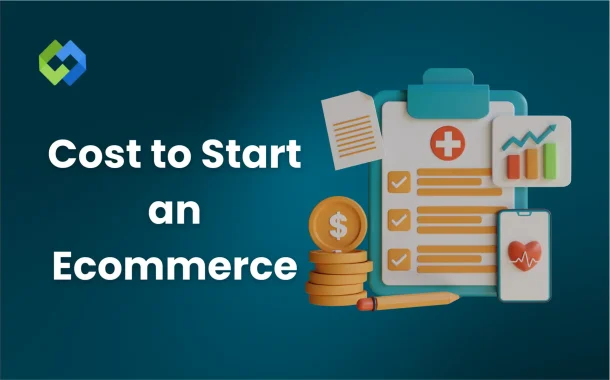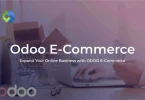Budget planning is crucial to success. Without a clear budget, costs can quickly spiral out of control. You need to know where every dollar is going. A well-thought-out budget helps you manage your money wisely. It ensures you have enough funds to cover all aspects of your business.
Table of Contents
Table of Contents
1. Domain and Hosting Costs
Domain and hosting are foundational costs for any ecommerce website development as a cost. A domain name is your website’s address, like “www.yourstore.com”. The cost of a domain typically ranges from $10 to $50 per year, depending on the name and extension (.com, .net, etc.). If you want a premium domain name, be prepared to pay significantly more. Choosing a memorable and relevant domain is crucial for establishing your brand identity and making it easy for customers to find you online.
Hosting is the service that stores your website’s files and makes them accessible on the Internet. There are different types of hosting options, each with its cost structure. Shared hosting, where your website shares server space with others, is the most affordable, usually costing between $5 to $10 per month.
However, it may offer limited resources and slower load times. If you need more control and better performance, consider VPS (Virtual Private Server) hosting, which starts at around $20 per month. Dedicated hosting, where you have an entire server to yourself, offers the best performance but comes with a higher price tag, often exceeding $100 per month.
2. Ecommerce Platform Costs
Ecommerce platform costs are a significant part of setting up your online store. These platforms provide the tools you need to build, manage, and run your ecommerce business. There are various options available, ranging from open-source platforms to subscription-based services, each with its own cost structure and features.
Open-source ecommerce platforms like WooCommerce or Magento are generally free to use, but they require you to handle the hosting, security, and maintenance yourself. While the initial cost might seem low, you’ll need to budget for web development, hosting, and additional plugins or extensions to enhance functionality. These costs can add up quickly, especially if you need custom features or professional help.
Subscription-based platforms like Shopify or BigCommerce offer a more all-inclusive solution. They handle hosting, security, and technical maintenance, allowing you to focus on running your business. Subscription costs typically start at around $29 per month for basic plans and can go up to $299 or more for advanced plans with additional features. These platforms also offer various plugins and apps, some of which may have additional costs.
3. Website Design and Development
Website design and development are critical components of launching a successful ecommerce business. The design of your website plays a key role in how customers perceive your brand and how easily they can navigate your online store. Development, on the other hand, ensures that your website functions smoothly, with all the necessary features to support your business operations.
You have two main options for website design: custom design or using templates. Custom design offers a unique look tailored specifically to your brand. However, this option can be expensive, with costs ranging from $2,000 to $10,000 or more, depending on the complexity and the designer’s expertise. Custom designs are ideal if you want your store to stand out and provide a unique user experience, but they require a larger investment upfront.
Using templates is a more budget-friendly option. Many ecommerce platforms offer pre-designed templates that you can customize to fit your brand. Template costs vary, with some available for free and others ranging from $50 to $200. While templates are less expensive and quicker to implement, they may not offer the same level of uniqueness or flexibility as a custom design.
4. Payment Processing Fees
Payment processing fees are a crucial consideration for any ecommerce business. These fees are charged by payment gateways and processors whenever a customer makes a purchase on your website. They cover the cost of securely handling transactions and transferring funds from the customer to your business. Understanding these fees is essential for pricing your products correctly and managing your overall budget.
Payment gateways, such as PayPal, Stripe, and Square, charge a percentage of each transaction plus a small fixed fee. Typically, the transaction fee is around 2.9% to 3.5% of the sale amount, with an additional fixed fee of about $0.30 per transaction. For example, if you sell a product for $100, you might pay around $3.20 to $3.80 in processing fees. These costs can add up quickly, especially if your business processes a high volume of sales, so it’s important to factor them into your pricing strategy.
Different payment methods can have varying fees. Credit cards, for instance, generally incur higher fees than other payment methods like direct bank transfers. Some payment gateways also charge additional fees for international transactions or currency conversion. If your business sells to customers in multiple countries, these extra fees can significantly impact your profit margins.
5. Inventory and Product Sourcing
Inventory and product sourcing are critical aspects of running an ecommerce business. How you source and manage your inventory directly impacts your cash flow, storage costs, and overall profitability. Whether you’re manufacturing products, purchasing from suppliers, or using dropshipping, understanding the costs involved is essential for maintaining a healthy business.
If you choose to purchase and store inventory yourself, the initial investment can be significant. You’ll need to buy products in bulk to get better pricing, which requires upfront capital. Depending on the type of products you sell, the initial inventory investment can range from a few hundred to several thousand dollars. Additionally, you’ll need to consider storage costs, especially if you deal with large or perishable items. Renting warehouse space or using third-party fulfillment centers will add to your expenses, but they can help streamline your operations and reduce shipping times.
Alternatively, dropshipping allows you to sell products without holding any inventory. When a customer places an order, the product is shipped directly from the supplier to the customer. This model significantly reduces upfront costs and eliminates the need for storage space. However, dropshipping often comes with higher product costs, lower profit margins, and less control over shipping times and quality.
6. Marketing and Advertising Expenses
Marketing and advertising expenses are essential for driving traffic to your ecommerce store and converting visitors into customers. Effective marketing strategies can significantly boost your sales, but they also require careful planning and budgeting. These expenses can vary widely depending on your approach, target audience, and the platforms you use.
Search Engine Optimization (SEO) is one of the foundational marketing strategies. SEO involves optimizing your website content to rank higher in search engine results, making it easier for potential customers to find your store. While basic SEO can be done in-house at a low cost, more advanced strategies might require hiring an SEO expert or agency, with fees ranging from a few hundred to several thousand dollars per month. Although SEO is a long-term investment, it can drive organic traffic to your site without ongoing ad spend.
Paid advertising, such as Pay-Per-Click (PPC) campaigns on Google Ads or social media platforms like Facebook and Instagram, offers more immediate results. These ads target specific demographics or keywords, bringing targeted traffic to your store. However, the costs can add up quickly, with typical PPC campaigns costing anywhere from $0.50 to $5.00 per click, depending on the competition in your niche.
7. Shipping and Logistics Costs
Shipping and logistics costs are vital components of your ecommerce business. Using Shipway can help track shipments and automate delivery updates, directly impacting customer satisfaction and profitability. These expenses include everything from shipping carrier fees to packaging and handling, and they can vary widely depending on your business model, product types, and shipping destinations.
Shipping carrier fees are one of the primary costs. Carriers like UPS, FedEx, and USPS charge based on package weight, dimensions, and delivery speed. Domestic shipping is generally more affordable than international shipping, but it can still add up, especially if you offer free or discounted shipping to customers. Standard shipping rates typically range from $5 to $15 per package for domestic orders, while international shipping can cost $20 or more, depending on the destination and service level. It’s important to negotiate rates with carriers and explore options like shipping software to manage costs effectively.
Packaging costs are another significant expense. Proper packaging protects your products during transit and enhances the customer experience. Basic packaging materials like boxes, bubble wrap, and tape may cost a few dollars per order, but customized or branded packaging can be more expensive. High-quality packaging not only safeguards your products but also helps reinforce your brand identity and create a positive impression.
8. Legal and Regulatory Costs
Legal and regulatory costs are essential considerations when running an ecommerce business.
Business Licensing and Permits
To operate legally, you need the appropriate business licenses and permits. The requirements vary by location and business type. Typical costs include registration fees for your business name and obtaining a sales tax permit if you’re selling taxable goods. Fees can range from $50 to $500, depending on your jurisdiction and the complexity of your business. Ensuring that you have all necessary permits and licenses helps you avoid fines and legal complications.
Taxes and Compliance Fees
Ecommerce businesses must adhere to tax regulations, including sales tax collection and remittance. The requirements depend on where you sell and where your customers are located. You might need to pay state and local sales taxes, and some jurisdictions require businesses to collect tax on online sales. Compliance with tax regulations often involves additional costs for accounting software or professional services. Tax-related expenses can vary widely, from a few hundred dollars for software to several thousand for ongoing accounting services.
Privacy Policy and Terms of Service
Drafting and maintaining a privacy policy and terms of service are crucial for legal compliance and customer trust. These documents outline how you handle customer data, return policies, and user responsibilities. Costs can include legal fees for drafting or reviewing these documents, which might range from $500 to $2,000, depending on the complexity and legal requirements. Properly crafted policies help protect your business from legal disputes and ensure transparency with your customers.
FAQs
Q. Do I need a business bank account for my ecommerce store?
Yes, it’s important to have a separate business bank account. It helps manage finances, track income and expenses, and maintain clear records.
Q. What are the costs of maintaining an ecommerce website?
Ongoing costs include domain renewal, hosting fees, software updates, and security measures. These can add up over time and should be factored into your budget.
Q. Are there additional costs for mobile app development?
If you want a mobile app for your ecommerce store, there will be additional costs. App development can range from a few thousand to several thousand dollars.
Q. How much should I budget for customer service tools?
Budget for customer service tools like live chat software or helpdesk systems. Costs vary, with some tools starting at around $20 per month.
Q. What are the costs of implementing returns and refund policies?
Implementing a returns and refund policy involves administrative costs and potentially higher shipping expenses for returns. Plan for these costs in your budget.
Conclusion
Starting an ecommerce business involves various costs, from domain and hosting fees to inventory and marketing expenses. Each area requires careful planning to ensure you stay within your budget and set your business up for success. Consider all the costs, including website design, payment processing, and shipping, to get a complete picture of your financial needs.
Effective budgeting is crucial to avoid unexpected expenses and maintain profitability. By understanding and managing these costs, you can make informed decisions and allocate resources wisely. This will help you build a strong foundation for your ecommerce business and achieve long-term success.














